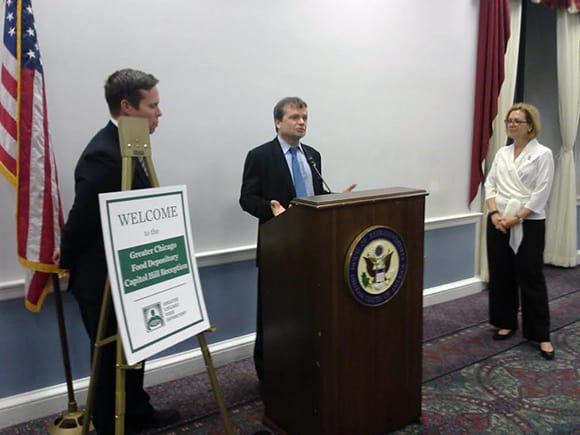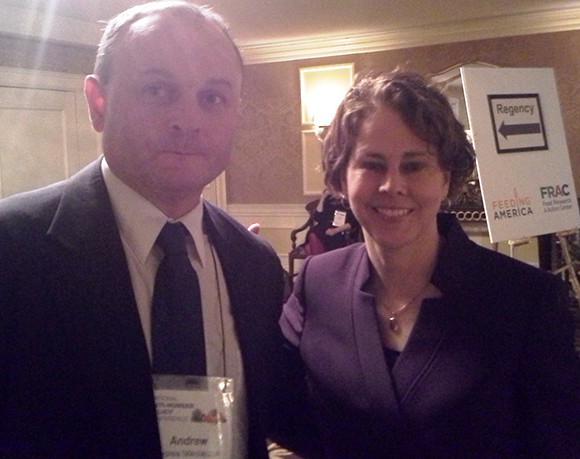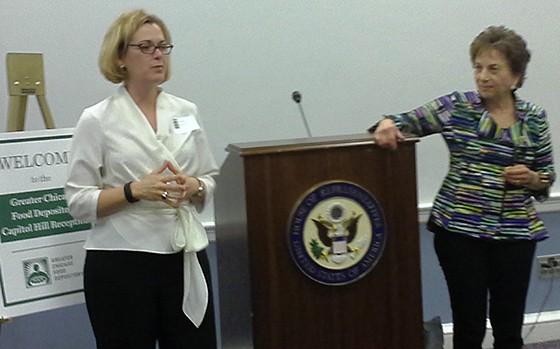
About 1,100 participants from all over the United States attended the Anti-Hunger Conference. This conference was sponsored Food Research and Action Center (FRAC) and Feeding of America.
Hunger and poverty affect over 48 million Americans. Check statistics in report:
A PLAN OF ACTION TO END HUNGER IN AMERICA
http://frac.org/pdf/plan-to-end-hunger-in-america.pdf
Federal nutritional programs provide a critical safety net and help millions of struggling household – including individual of all ages – to put food on the table during times of need. Hunger increases health care costs, lowers worker productivity, harms children development and diminishes children’s educational performance.
SNAP/Food Stamps- The Supplemental Nutrition Assistance Program. The SNAP/Food Stamp Program is the largest, the strongest and most effective governmental federal nutrition program operated by the United States Department of Agriculture (USDA) and administered by state agencies. This program serves over 48 million Americans: families, children, youth, seniors across the United States. The program has been in existence for several decades.

As of Oct. 1, 2008, Supplemental Nutrition Assistance Program (SNAP)is the new name for the federal Food Stamp Program. The new name reflects the changes that were made to meet the needs of clients, including a focus on nutrition and an increase in benefit amounts. SNAP is the federal name for the program. State programs may have different names
Tom Vilscak, Secretary of the Department of Agriculture was one of the key Plenary Speakers during the Anti-Hunger Conference in Washington.
Secretary Vilsack provided important updates at the Anti-Hunger Conference about food programs for families, youth and seniors. He focused on children and youth. These programs have been expanded during last decade and reach most of the United States schools and help children and youth from low income families to get at least one food program a day.
There is a strong correlation between good nutrition for children and youth and their better academic development, school progress etc.
Vilsack presented a list of successes – expansion in school breakfast and lunch programs is schools around the United States.
According to Secretary Vilsack we have seen progress in the last seven years, reducing food insecurity among children from 17 million to 15 million.
In his remarks about SNAP benefits, he referred to an increased participation in the program nationwide, but outreach still needs to expand.
Hon. J. Schakowsky and Kate Maehr
Summers are critical for many children and youth when they finish academic year in regards to school food programs. „We should not let a single child go hungry during the summer.” Nutrition is critical for children academic work and personal development. „We know that when we feed our children well, it makes a difference”, said Vilsack.
Secretary Vilsack talked during his remarks about importance of mentorship for young children and youth. He shared his own incredible story of being adopted and being raised by his adopted parents.
Secretary Vilsack referred to proposals that would require drug testing for SNAP recipients. He is decidedly not in favor of such solution. „This is a program that provides stability in this country. I am tired of the discussion in this country that seeks to divide those who struggle and those who have succeeded. We must bring people together.”
Vilsack closed his remarks to another standing ovation: „Let’s make sure that this country understands that when ordinary people stand up, and are concerned about their neighbors, we can be an America that we are proud of and can be the America that the world wants us to be.”

U.S. Representative Mike Quigley and Kate Maehr
SNAP, formerly known as the Food Stamp Program, provides low-income households with a monthly Electronic Benefit Transfer (EBT) card that can be used, like a debit card, to buy food at most grocery stores and other food retailers, including farmers’ markets.
The idea of federal nutrition programs is to lift many households out of poverty, whenever it is possible. It is estimated that SNAP lifted 3.6 million people out of poverty in 2014.
In addition to helping families and individuals put healthy food on the table,USDA research shows every $1 of SNAP/Food Stamps spent in the community generates $1.79 in local economic activity.
“The Supplemental Nutrition Assistance Program (SNAP) is the cornerstone of the Nation’s nutrition assistance safety net. Benefits are available to most people who meet the financial and nonfinancial requirements, and the program serves a broad spectrum of low income people. In Fiscal Year 2013, SNAP provided about $3.4 billion dollars in food benefits to a monthly average of 2,040,053 people in Illinois. The program served 92 percent of those eligible for benefits in Illinois in 2012. SNAP also has an economic multiplier effect; every dollar in new SNAP benefits results in $1.80 in total economic activity”.
http://www.fns.usda.gov/ops/snap-community-characteristics-illinois
Diana Aviv, Feeding America CEO, introduced Virginia First LadyDorothy McAuliffe who is a champion of the fight against hunger in her own state.
McAuliffe made a strong introduction when starting her speech by saysing: „It’s a national disgrace that in the most prosperous nation in the world, there are citizens who go hungry.”
McAuliffe presented number of actions that Virginia has excelled in improving school nutrition: „We cannot expect our children to be hungry for knowledge if they are just plain hungry.”
There are states in the United States like Virginia that have pilot nutritional food programs that offers meals three times a day.
First Lady of Virginia made it clear that children and youth need support, protection to deal with hunger and poverty. „Hungry children simply don’t have the tools they need to break the cycle of poverty.”
Cecilia Munoz, the White House Advisor for Domestic issues was another Plenary Speaker during the Anti-Hunger Policy Conference in Washington.
Munoz promised that we might see in the next 12 months: stronger TANF, a summer EBT program.
She’s talked about intense discussion in Washington over different issues. There is a lot of evidence that different things can get done. As an example she presented: the Let’s Move initiative by Michelle Obama, the First Lady of the United States. The other example is the decrease in veteran homelessness in some states.
Munoz mentioned about Anti-Hunger Conference that took place at the White House several weeks earlier.
It is very important to share that many elected officials from Illinois are champions of the fight against hunger not only in Illinois but on national scale. They have been doing it for years or decades.
https://www.facebook.com/fooddepository/

Andrew Mikolajczyk and Cecilia Munoz
Food insecurity and poverty are serious problems for millions of Americans, including seniors. Thousands of seniors struggle to cover housing costs, medical care, and still pay for food on a fixed income.
One of a key part solution to ending senior hunger is to connect eligible seniors to SNAP/Food Stamps programs, community programs. SNAP/Food Stamps is a particularly effective tool for addressing senior hunger. There is a great need for continuity of this program.We have been referring needy older adults and others to the appropriate governmental and community agencies.
Food banks across the country continue to see high levels of need as families struggle to recover from the recession. The economic recovery has left too many low income families behind, with millions working part-time and unable to meet the ends. The jobs are the best solution to hunger.
What are the best ways to resolve hunger problem in America? Obviously, there are not quick fixes and immediate solutions for everything. The need for food assistance remains high in the communities. Food banks are struggling to keep with increased demands. Charities and government must work together to meet the needs so that „no one should go hungry”.
Video from GCFD: relation by Andrew Mikolajczyk.
https://mail.google.com/mail/u/0/#search/andrew.mikolajczyk%40gmail.com/15353f12e358a34c?projector=1
@ Andrew (Andrzej) Mikolajczyk

